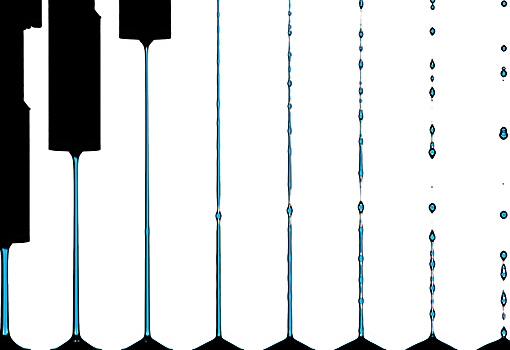A postdoctoral researcher in the lab of UC Santa Barbara assistant professor of mechanical engineering Alban Sauret has won the prestigious Milton van Dyke award for best video in the Annual Gallery of Fluid Motion, presented by the Division of Fluid Dynamics (DFD) at the 74th annual meeting of the American Physical Society.
Postdoc Virgile Thiévenaz and Sauret were named winners of the award, which is given to the makers of videos and posters that “capture the beauty of fluid dynamics that we encounter both in our everyday lives and in highly specialized applications, in a way our eyes cannot observe otherwise,” said Gokul Pathikonda, assistant professor in the School for Engineering of Matter, Transport and Energy at Arizona State University and the local organizer for the Gallery. The meeting was held in Phoenix in November.
Winning videos and posters are required to have brains and beauty by presenting new research findings in a visually appealing way. A panel of scientists evaluated a total of 143 entries comprising, 98 videos and 45 posters, from around the world, based on both their aesthetic and scientific qualities. The top prizes in each category are named for the late Stanford University fluid mechanics professor Milton Van Dyke, whose 1982 book An Album of Fluid Motion, consisting almost entirely of photographs depicting various concepts, principles, and processes in fluid dynamics, has inspired researchers in the field for decades.
In the winning video, titled “Fragmentation of two-phase compound liquid ligaments,” ultra-slow-motion video is used to depict how various compound liquids — i.e. those composed of two or more different liquids that do not mix, such as water and viscous oil — break apart under pulling force within a capillary bridge, formed between a still rod and a moving rod. The stretching causes a ligament to form. In low-viscosity liquids, such as water, the ligament quickly detaches, first from the still rod and then from the moving rod. End pinching then generates capillary waves, which ripple across the ligaments, destabilizing the system and causing the ligaments to break into tiny droplets.
The video then shows ligament formation and breakage when the liquid is viscous oil, and then with various mixtures of water and viscous oil, and, finally, with drops of two different liquids contained within the oil. Simple, clear text describes the various processes and the results shown in the video, while piano music by renowned French composer Erik Satie lends an elegance to the presentation, transforming the ligament formation, breakage, and atomization into a kind of dance of fluid entities.
To make the video, Thiévenaz used a high-speed camera, which made it possible to slow the live action by a factor of one hundred, making visible pinching events that lasted only a few milliseconds in real time. “A lot of things can go wrong, so you need to pay attention to many small technical details when shooting,” says Thiévenaz, who used a macro lens set up about ten inches from the experiments. “The lighting might not be correct, or the oil is not captured properly in the capillary, or the depth of field is off. If the focus is not sharp, you won’t capture the beauty of it. It’s much easier to get useful data than to get something beautiful. I think I shot several hundred takes and finally got about five that were usable.”
The atomization of liquids, even without compound droplets, has application in many areas,” Thiévenaz says. “With COVID, for instance, first you have a volume of liquid that is put under large stresses, by coughing or sneezing. That creates ligaments, which then destabilize to make droplets. If you want to know, for example, how long the droplets will remain floating in the air, you need to know their size.”
“Our take on the atomization of fluids is really what happens if the fluids are complex — for example, when there are polymers, droplets, or particles dispersed in the liquid. How does that change the size and distribution of drops, the number of drops, and so on,” says Sauret. “Every time liquids break, even rain drops, polymer solutions, whatever you can think of, the last step before making micro-droplets are these long filaments. Can you tune the atomization process to control them? That is the very first step.”
Sauret says that the research depicted in the video is in its earliest stages and, therefore, a very long way from any such application. The next time-consuming steps will involve producing mathematical models and then computational simulations of the processes depicted in the video to try to establish some generalizable findings.
Other applications include determining the size of droplets in coatings that are applied by spraying; the spraying of agricultural pesticides, where it is important to get the chemical to stick to the leaves (thus, the droplets cannot be too heavy) while ensuring that it does not drift beyond the field where it is applied, meaning the droplets cannot be too small or too light. Fertilizers are a related application, but there, it is desirable to have larger, heavier drops so that the nutrients fall to the soil.
Videos of this kind are very useful in teaching and outreach, says Sauret. “I use them in class to teach fluid mechanics. It’s a good way of communicating a complex process.”

A still image from the video, showing (from left) one steel rod (top) pulling away from the other, causing the liquid to stretch and form filaments, which eventually break into droplets.
